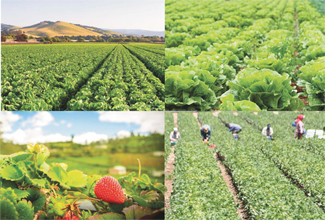
What’s in a name? For Salinas Valley, it means rich soil and verdant fields. Yet this famous region—where significant quantities of leafy greens, strawberries, grapes, broccoli, cauliflower, and much more are produced—is not immune to challenges.
Situated along the Salinas River and less than 10 miles from the Pacific Ocean, Salinas holds a rich history of agriculture and growth. In the late 1800s, irrigation came to the valley and for the next three decades, sugar beets were the dominant crop, later giving way to lettuce, or what was then “green gold.” The agricultural boom in the 1930s and ’40s drew beleaguered Dust Bowl workers from around the country, as well as Mexican workers through the Bracero program. Over the ensuing 60 years, Salinas continued to grow, but not without pains such as worker strikes in the ’70s, water pollution and an earthquake in the ’80s, floods in the ’90s, and a deadly E. coli outbreak in spinach in 2006.
Today, the Salad Bowl continues to be a top producer of fresh vegetables despite ongoing challenges that include drought and labor shortages.
Commodities in the Valley
Salinas is particularly well suited to growing greens and other vegetables. “We are so close to the ocean that when the rest of the nation is experiencing heat, we have cool evenings from ocean fog that allow us to grow certain kinds of produce,” explains Joe Kaslin, VP of sales and marketing at grower-shipper Bengard Ranch, Inc., which specializes in lettuce, broccoli, cauliflower, celery, and green onions, as well as parsley and cilantro.
Although the Valley is known as the Salad Bowl and acreage was once dominated by lettuce and other leafy greens, Salinas growers now produce more strawberries than iceberg lettuce. A variety of leafy greens are still high on the production list, but other top commodities include grapes, cauliflower, sugar snap peas, raspberries, Brussels sprouts, and artichokes.
“Strawberries took over iceberg lettuce last year, followed by broccoli, cauliflower, and then celery,” comments Ron Fuqua, Jr., president of Salinas-based distributor A & R Fresh, LLC, who believes the increased berry output is likely fueled by the ongoing consumer trend to eat healthier.
Bill Armstrong, owner of Armstrong Marketing, which handles both fruit and vegetables, believes the high level of antioxidants in strawberries is driving the trend, with growers like Driscoll’s touting these health benefits.




